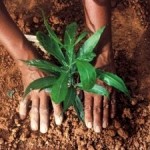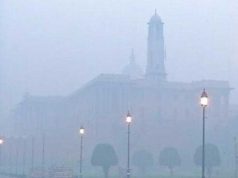The State of the Environment
The AEO-3 built the above messages and recommendations from the latest data available on air quality, biodiversity, chemicals and waste, climate change, freshwater and sanitation and land. This existing data on linkages between health and the environment in Africa needs to be brought up to date.
The data available includes the following facts and figures:
Air Quality
- The low combustion efficiency of solid fuels used for cooking and heating in rural Africa and poor ventilation often results in concentrations of indoor air pollution 10-30 times over World Health Organization limits.
- Outdoor air pollution is estimated to kill 800,000 people globally each year, mainly in urban areas; 40,000 of these deaths occur in Africa.
- In Angola, 6.9 per cent of the national disease burden is attributable to solid fuel use; in Malawi, the figure is 5.2 per cent.
Biodiversity
- Africa’s biological diversity supports human health as a major source of food, medicines and ecosystem services: 80 per cent of Africa’s rural population depends on traditional medicine. In Zimbabwe, 50 species of mushrooms, 25 species of fruit and 50 species of leafy vegetables are harvested from the wild.
- Uncontrolled exploitation and fragmentation of natural habitats threaten biodiversity of medicinal and food security value. Over-harvesting and climate change also contribute to biodiversity degradation and imbalances in predator-prey relationships that may create conditions for disease outbreak.
- Changes or disturbance in habitats characterized by damming, destruction of coral reefs through dynamite fishing, and the conversion of natural forests and grasslands into arable agriculture also create conditions that may favour disease vectors.
 Chemicals and Waste
Chemicals and Waste
- Health-related risks in Africa come from agrochemicals, persistent organic pollutants (POPs), chemical stockpiles, e-Waste and petroleum waste.
- In Ivory Coast, the National Centre for Agronomical Research in Abidjan estimates that 65 per cent of the illnesses suffered by market gardeners, cotton growers, mango producers and consumers are due to pesticides.
- The Ogoni community in the Niger Delta in Nigeria is exposed to petroleum hydrocarbons in outdoor air and drinking water, sometimes at elevated concentrations. Furthermore, community members at Nisisioken Ogale are drinking water from wells that are contaminated with benzene, a known carcinogen, at levels over 900 times above WHO limits.
Climate Change
The Fourth Assessment of the Inter-Governmental Panel on Climate Change (IPCC) found that Africa is warming faster than the global average, and temperature could increase by as much as 3 to 4°C average this century. This makes climate change a major challenge for health and economy in Africa as climate-sensitive diseases are likely to spread with warming. These include Rift Valley Fever, which affects both people and livestock; cholera, associated with floods; Meningitis, associated with prolonged warming; and Malaria, which warming has enabled the emergence of in hitherto unexposed areas such as the highlands of Kenya, Rwanda and Tanzania. The effects of warming in Africa are also likely to translate into reductions in crop yields and livestock productivity, shortages of drinking water, and displacement of people in some areas.
Freshwater and Sanitation
- Human-induced pollution in Africa comes from untreated municipal wastewater effluents, seepage to natural wells and springs from latrines, nitrate pollution of groundwater by fertilizers, cadmium-rich water releases from phosphates mines, and eutrophication of dam reservoirs as a result of organic pollution.
- The majority of Africa’s population still lacks safe drinking water, with sub-Saharan Africa accounting for about a third or 330 million of the 884 million people who have no access worldwide.
- Although by 2010 the actual number of people using improved drinking water sources had increased by 11 per cent since 1990, only 60 per cent of the sub-Saharan Africa population had access to safe water.
- Northern Africa is the only sub-region that has surpassed the Millennium Development Goal sanitation targets, with access coverage increasing from 72 per cent in 1990 to 89 per cent in 2008.
- Water scarcity is projected to increase from 47 per cent in 2000 to 65 per cent in 2025.
Land
- By sustainably using land, people can enhance their health through increased access to the various ecosystem services, yet Africa suffers considerable land degradation, with severe consequences for agricultural production, nutrition and human health.
- In a period covering over 50 years from 1950, soils in about 0.5 million square kilometres were degraded. Over 60 per cent of the population in Burkina Faso, Ethiopia, Lesotho and Mali live on degraded land.
- Changes in land use can also change the ecology of human diseases, thereby making people more vulnerable to infections. Indirect health effects of land degradation include the spread of infectious diseases as populations migrate.
- Africa is estimated to contribute 70 per cent of the global land leased or purchased to produce agricultural crops for food and for bio-fuels, with adverse impacts on local food security and livelihoods.
Source: UNEP.
Notes:
The Africa Environment Outlook (AEO) is a tool of the African Ministerial Conference on the Environment (AMCEN) for monitoring environmental management in Africa. It provides a framework for environmental reporting at the national and sub-regional levels. Its ultimate aim is to enable AMCEN’s member countries to institute environmental management policies and programmes for the sustainable future of the continent. The AMCEN Secretariat partners with the United Nations Environment Programme (UNEP), through its Regional Office for Africa (ROA) and the Division of Early Warning and Assessment (DEWA), in producing the AEO report.















